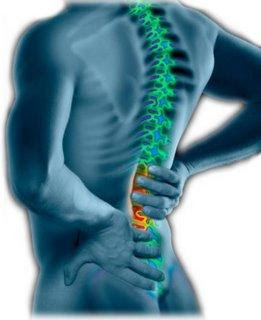Lower Back Pain. Lower back pain is very common. Each year, the treatment of lower back pain spent more than 80 billion U.S. dollars, and insurance claims for disability due to lower back pain exceed $ 8 billion. Thus, despite lower back pain resulting from the disorder is rarely life-threatening, this is a significant health problem. Even so, the number of back injuries in the workplace declined, probably because of awareness on these issues has increased and the ways to deal with has increased.
 The backbone (spinal column) consists of the spine (vertebrae), which is separate and pillowed per-absorption disk made of cartilage. Spinal cord is also protected by a thin layer of cartilage. They are sustained by the joints and muscles, which helps balance the spine. These muscles include the iliopsoas muscle (which is along both sides of the spine), the second backbone enforcement muscle (which is down along both sides of the backbone behind them), and a lot of short paraspinal muscles (which run along between the spine). Abdominal muscles (which run along the bottom of the chest cavity to the pelvis) also helps balance the spine.
The backbone (spinal column) consists of the spine (vertebrae), which is separate and pillowed per-absorption disk made of cartilage. Spinal cord is also protected by a thin layer of cartilage. They are sustained by the joints and muscles, which helps balance the spine. These muscles include the iliopsoas muscle (which is along both sides of the spine), the second backbone enforcement muscle (which is down along both sides of the backbone behind them), and a lot of short paraspinal muscles (which run along between the spine). Abdominal muscles (which run along the bottom of the chest cavity to the pelvis) also helps balance the spine.
Attached to the spine is the spinal cord. Throughout the spinal cord, spinal nerves arise through the space between the spinal column to connect with nerves throughout the body. section on the spinal nerve near the spinal cord called the spinal nerve roots. Because of their location, the spinal nerve roots can be depressed when the injured spinal cord, causing pain.
The lower spine (lumbar) consists of five vertebrae. Connecting the chest to the pelvis and legs, resulting in motion-to turn, rotate, and bend. Which also produces the strength to stand, walk, and stood on tiptoe. Thus, the spine associated with nearly all activities of daily living. Back pain can limit the range of activities and reduce quality of life.
 The backbone (spinal column) consists of the spine (vertebrae), which is separate and pillowed per-absorption disk made of cartilage. Spinal cord is also protected by a thin layer of cartilage. They are sustained by the joints and muscles, which helps balance the spine. These muscles include the iliopsoas muscle (which is along both sides of the spine), the second backbone enforcement muscle (which is down along both sides of the backbone behind them), and a lot of short paraspinal muscles (which run along between the spine). Abdominal muscles (which run along the bottom of the chest cavity to the pelvis) also helps balance the spine.
The backbone (spinal column) consists of the spine (vertebrae), which is separate and pillowed per-absorption disk made of cartilage. Spinal cord is also protected by a thin layer of cartilage. They are sustained by the joints and muscles, which helps balance the spine. These muscles include the iliopsoas muscle (which is along both sides of the spine), the second backbone enforcement muscle (which is down along both sides of the backbone behind them), and a lot of short paraspinal muscles (which run along between the spine). Abdominal muscles (which run along the bottom of the chest cavity to the pelvis) also helps balance the spine.Attached to the spine is the spinal cord. Throughout the spinal cord, spinal nerves arise through the space between the spinal column to connect with nerves throughout the body. section on the spinal nerve near the spinal cord called the spinal nerve roots. Because of their location, the spinal nerve roots can be depressed when the injured spinal cord, causing pain.
The lower spine (lumbar) consists of five vertebrae. Connecting the chest to the pelvis and legs, resulting in motion-to turn, rotate, and bend. Which also produces the strength to stand, walk, and stood on tiptoe. Thus, the spine associated with nearly all activities of daily living. Back pain can limit the range of activities and reduce quality of life.